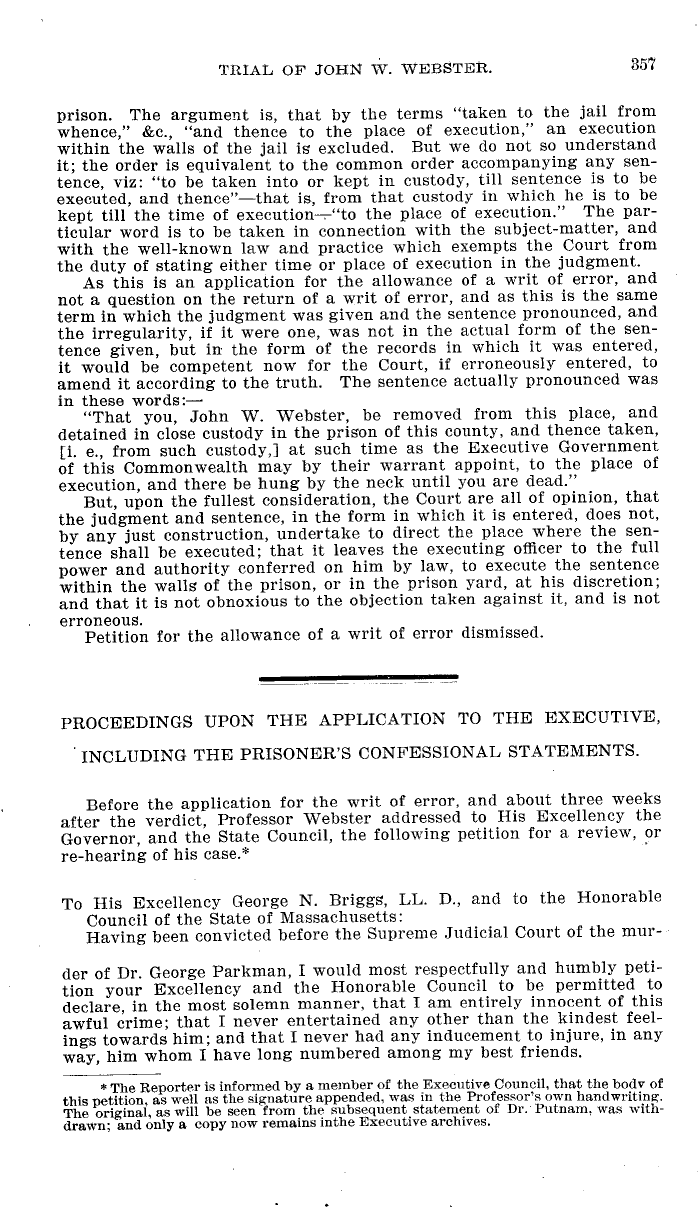|
TRIAL OF JOHN W. WEBSTER. 357
prison. The argument is, that by the terms "taken to the jail from
whence," &c., "and thence to the place of execution," an execution
within the walls of the jail is excluded. But we do not so understand
it; the order is equivalent to the common order accompanying any sen-
tence, viz: "to be taken into or kept in custody, till sentence is to be
executed, and thence"-that is, from that custody in which he is to be
kept till the time of execution-"to the place of execution." The par-
ticular word is to be taken in connection with the subject-matter, and
with the well-known law and practice which exempts the Court from
the duty of stating either time or place of execution in the judgment.
As this is an application for the allowance of a writ of error, and
not a question on the return of a writ of error, and as this is the same
term in which the judgment was given and the sentence pronounced, and
the irregularity, if it were one, was not in the actual form of the sen-
tence given, but in the form of the records in which it was entered,
it would be competent now for the Court, if erroneously entered, to
amend it according to the truth. The sentence actually pronounced was
in these words:-
"That you, John W. Webster, be removed from this place, and
detained in close custody in the prison of this county, and thence taken,
[i. e., from such custody,] at such time as the Executive Government
of this Commonwealth may by their warrant appoint, to the place of
execution, and there be hung by the neck until you are dead."
But, upon the fullest consideration, the Court are all of opinion, that
the judgment and sentence, in the form in which it is entered, does not,
by any just construction, undertake to direct the place where the sen-
tence shall be executed; that it leaves the executing officer to the full
power and authority conferred on him by law, to execute the sentence
within the walls of the prison, or in the prison yard, at his discretion;
and that it is not obnoxious to the objection taken against it, and is not
erroneous.
Petition for the allowance of a writ of error dismissed.
PROCEEDINGS UPON THE APPLICATION TO THE EXECUTIVE,
INCLUDING THE PRISONER'S CONFESSIONAL STATEMENTS.
Before the application for the writ of error, and about three weeks
after the verdict, Professor Webster addressed to His Excellency the
Governor, and the State Council, the following petition for a review, or
re-hearing of his case."
To His Excellency George N. Briggs, LL. D., and to the Honorable
Council of the State of Massachusetts:
Having been convicted before the Supreme Judicial Court of the mur-
der of Dr. George Parkman, I would most respectfully and humbly peti-
tion your Excellency and the Honorable Council to be permitted to
declare, in the most solemn manner, that I am entirely innocent of this
awful crime; that I never entertained any other than the kindest feel-
ings towards him; and that I never had any inducement to injure, in any
way, him whom I have long numbered among my best friends.
* The Reporter is informed by a member of the Executive Council, that the
bodv of
this petition, as well as the signature appended, was in the Professor's
own handwriting.
The original, as will be seen from the subsequent statement of Dr. Putnam,
was with-
drawn; and only a copy now remains inthe Executive archives.
|

